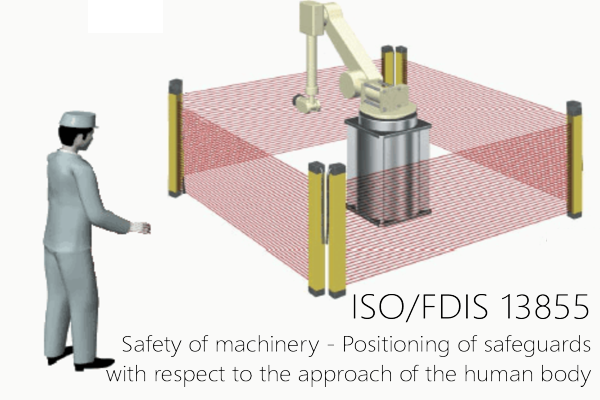Decisione di esecuzione (UE) 2020/260

Decisione di esecuzione (UE) 2020/260
Decisione di esecuzione (UE) 2020/260 della Commissione del 25 febbraio 2020 che modifica la decisione di esecuzione (UE) 2019/1202 per quanto riguarda la prevenz...
ID 19838 | 18.06.2023 / In allegato Preview
UNI EN ISO 3691-4:2023
Carrelli industriali - Requisiti di sicurezza e verifiche - Parte 4: Carrelli industriali senza guidatore a bordo e loro sistemi
ISO 3691-4:2023
Carrelli industriali - Requisiti di sicurezza e verifiche - Parte 4: Carrelli industriali senza guidatore a bordo e loro sistemi
La norma specifica i requisiti di sicurezza e i mezzi per la loro verifica per i carrelli industriali senza guidatore e i loro sistemi.
Automated Guided Vehicle / Laser Guided Vehicle (AGV-LGV)
________
Questa seconda edizione annulla e sostituisce la prima edizione (ISO 3691-4:2020), che è stata tecnicamente rivista.
Le principali modifiche sono le seguenti:
- l'ambito di applicazione è stato aggiornato per includere un elenco di pericoli significativi non coperti;
- l'elenco dei riferimenti normativi è stato aggiornato per includere le più recenti edizioni dei documenti;
- alla clausola 3 sono state aggiunte le voci "campo di rilevamento attivo" e "arresto operativo";
- la clausola 4, la clausola 5, la clausola 6, l'allegato A, l'allegato B e l'allegato C sono stati aggiornati, con l'aggiunta di nuovi requisiti nelle sottoclausole da 4.1.16 a 4.1.27;
- la verifica degli elenchi dei requisiti di sicurezza di cui all'allegato E è stata riformulata.
...
Industrial trucks - Safety requirements and verification - Part 4: Driverless industrial trucks and their systems
This document specifies safety requirements and the means for their verification for driverless industrial trucks (hereafter referred to as trucks) and their systems.
Examples of driverless industrial trucks (trucks as defined in ISO 5053‑1:2020) include: “automated guided vehicle”, “autonomous mobile robot”, “bots”, “automated guided cart”, “tunnel tugger”, “under cart”, etc.
This document is also applicable to driverless industrial trucks which are provided with:
- automatic modes which either require operators’ action(s) to initiate or enable such automatic operations;
- the capability to transport one or more riders (which are neither considered as drivers nor as operators);
- additional manual modes which allow operators to operate the truck manually; or
- a maintenance mode which allows manual operation of truck functions for maintenance reasons.
This document is not applicable to trucks solely guided by mechanical means (rails, guides, etc.) or to remotely-controlled trucks, which are not considered to be driverless trucks.
For the purposes of this document, a driverless industrial truck is a powered truck, which is designed to operate automatically. A driverless truck system comprises the control system, which can be part of the truck and/or separate from it, guidance means and power system. Requirements for power sources are not covered in this document.
The condition of the operating zone has a significant effect on the safe operation of the driverless industrial truck. The preparations of the operating zone to eliminate the associated hazards are specified in Annex A.
This document is applicable to all significant hazards, hazardous situations or hazardous events during all phases of the life of the truck (ISO 12100:2010, 5.4), as listed in Annex B, relevant to the applicable machines when it is used as intended and under conditions of misuse which are reasonably foreseeable by the manufacturer.
In particular, this document does not apply to significant hazards related to:
- noise;
- vibrations;
- ionising and non-ionising radiation;
- laser radiation;
- sales literature (commercial documents);
- declaration of vibrations transmitted by mobile machinery.
It does not apply to additional hazards that can occur:
- during operation in severe conditions (e.g. extreme climates, freezer applications, strong magnetic fields);
- during operation in nuclear environments;
- from trucks intended to operate in public zones (see in particular ISO 13482:2014);
- during operation on a public road;
- during operation in potentially explosive environments;
- during operation in military applications;
- during operation with specific hygienic requirements;
- during operation in ionizing radiation environments;
- during the transportation of (a) person(s) other than (the) intended rider(s);
- when handling loads the nature of which can lead to dangerous situations (e.g. molten metals, acids/bases, radiating materials);
- for rider positions with elevation function higher than 1 200 mm from the floor/ground to the platform floor.
This document does not contain safety requirements for trailer(s) being towed behind a truck.
This document does not contain safety requirements for elevated operator trucks.
This document does not apply to trucks manufactured before the date of its publication.
Preview in allegato
Collegati

Decisione di esecuzione (UE) 2020/260 della Commissione del 25 febbraio 2020 che modifica la decisione di esecuzione (UE) 2019/1202 per quanto riguarda la prevenz...

Rettifica della decisione di esecuzione (UE) 2019/451 della Commissione, del 19 marzo 2019, relativa alle norme armonizzate per i prodotti da costruzion...

ID 20386 | Update news 26.11.2024 Status: Pubblicata 22.11.2024
26.11.2024 / Pubblicata
Testata editoriale iscritta al n. 22/2024 del registro periodici della cancelleria del Tribunale di Perugia in data 19.11.2024